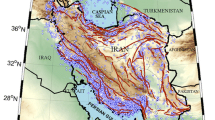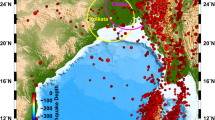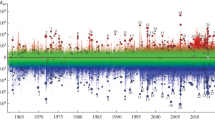Abstract
The Aegean and surrounding area (34°N–43°N, 18°E–30°E) is separated into 76 shallow and intermediate depth seismogenic sources. For 74 of these sources intervent times for strong mainshocks have been determined by the use of instrumental and historical data. These times have been used to determine the following empirical relations:
whereT 1 is the interevent time, measured in years,M min the surface wave magnitude of the smallest mainshock considered,M p the magnitude of the preceding mainshock,M f the magnitude of the following mainshock,\(\dot M_0 \) the moment rate in each source per year. A multiple correlation coefficient equal to 0.74 and a standard deviation equal to 0.18 for the first of these relations were calculated. The corresponding quantities for the second of these relations are 0.91 and 0.22.
On the basis of the first of these relations and taking into consideration the time of occurence and the magnitude of the last mainshock, the probabilities for the occurrence of mainshocks in each seismogenic source of this region during the decade 1993–2002 are determined. The second of these relations has been used to estimate the magnitude of the expected mainshock.
Similar content being viewed by others
References
Bevington, P. R.,Data Reduction and Error Analysis for the Physical Sciences (McGraw-Hill, New York 1969).
Bufe, C. G., Harsh, P. W., andBurford, R. D. (1977),Steady-state Seismic Slip: A Precise Recurrence Model, Geophys. Res. Lett.4, 91–94.
Comninakis, P. E., andPapazachos, B. C. (1986),A Catalogue of Earthquakes in Greece and Surrounding Area for the Period 1901–1985, Publ. Geophys. Lab. Univ. Thessaloniki 1, 167 pp.
Dahle, A., Bungum, H., andKramme, L. (1990),Attenuation Models Inferred from Intraplate Earthquake Recordkngs, Earthquake Eng. Struct. Dyn.19, 1125–1141.
Draper, N. R., andSmith, H.,Applied Regression Analysis (Wiley, New York 1966) 407 pp.
Fukushima, Y., Tanaka, T., andKataoka, T. (1989),A New Attenuation Relationship for Peak Ground Accelerations Derived From Strong-motion Accelerograms, Proc. 9th World Conf. Earthq. Eng., Tokyo-Kyoto, Japan,2, 343–348.
Gutenberg, B., andTichter, C. F. (1944),Frequency of Earthquakes in California, Bull. Seismol. soc. Am.34, 185–188.
Jackson, J., andMcKenzie, D. (1988),The Relationship between Plate Motions and Seismic Moment Tensors, and the Rate of Active Deformation in the Mediterranean and Middle East, Geophys. J.93, 45–73.
Joyner, W. B., andBoore, D. M. (1981),Peak Horizontal Acceleration and Velocity from Strong-motion Records including Records from the 1979 Imperial Valley, California Earthquake, Bull. Seismol. Soc. Am.71, 2011–2038.
Karakaisis, G. F., Kourouzidis, M. C., andPapazachos, B. C. (1991),Behavour of Seismic Activity during a Single Seismic Cycle, Int. Conf. Earthq. Pred., Strasbourg, 15–18 October 1991,1, 47–54.
Kiratzi, A. A., andPapazachos, C. B. (1993),Active Seismic Deformation in the Southern Aegean Benioff Zone, Publ. Geophys. Lab., Univ. of Thessaloniki,1, 17 pp.
Kostrov, V. (1974),Seismic Moment and Energy of Earthquakes and Seismic Flow of Rock, Izv. Acad. Sci. USSR Phys. Solid Earth1, 23–44.
McGuire, R. (1978),Seismic Ground Motion Parameter Relation, Proc. ASCE J. Geotech. Eng. Div.104, 481–490.
Milne, W. G., andDavenport, A. G. (1969),Determination of Earthquake Risk in Canada, Bull. Seismol. Soc. Am.59, 729–754.
Mogi, K. (1962),On the Time Distribution of Aftershocks Accompanying the Recent Major Earthquakes in the Near Japan, Bull. Earthq. Res. Inst.40, 107–124.
Mogi, K. (1981),Seisnicity in western Japan and Long-term earthquake forecasting. InEarthquake Prediction, An International Review, Maurice Ewing Ser. Vol. 4 (eds Simpson D. W., and Richards, P. G.) (AGU, Washington, D.C. 1981) pp. 43–52.
Molnar, P. (1979),Earthquake Recurrence Intervals and Plate Tectonics, Bull. Seismol. Soc. Am.69, 115–133.
Pacheco, J. F., andSykes, L. R. (1992),Seismic Moment Catalog of Large Shallow Earthquakes, 1900–1989, Bull. Seismol. Soc. Am.82, 1306–1349.
Papazachos, B. C. (1974),On Certain Aftershock and Foreshock Parameters in the Area of Greece, Annali. di Geof.27, 497–515.
Papazachos, B. C. (1988a),Seismic Hazard and Long-term Earthquake Prediction in Greece, European School of Earthquake Sciences, Course on Earthquake Hazard Assessment, Athens, Greece, 9–16 May, 1988, pp. 1–10.
Papazachos, B. C. (1988b),Long-term Prediction of Earthquakes in Seismogenic Sources of Greece, UN Sem. on Prediction of Earthquakes, Lisbon-Portugal, 14–18 November 1988, pp. 1–10.
Papazachos, B. C. (1989),A Time-predictable Model for Earthquake Generation in Greece, Bull. Seismol. Soc. Am.79, 77–84.
Papazachos, B. C. (1990),Seismicity of the Aegean and Surrounding Area, Tetonophys.178, 287–308.
Papazachos, B. C. (1992),A Time and Magnitude Predictable Model for Generation of Shallow Earthquakes in the Aegean Area, Pure Appl. Geophys.138, 287–308.
Papazachos, B. C. (1993),Long-term Prediction of Intermediate Depth Earthquakes in Southern Aegean Region Based on a Time Predictable Model, Natural Hazards7, 211–218.
Papazachos, C. B., andKiratzi, A. A. (1993),A Formulation for Reliable Estimation of Active Crustal Deformation and its Application in Greece, Geophys. J. Intern.111, 424–432.
Papzachos, B. C., andPapazachou, C. B.,The Earthquakes of Greece (Ziti Publishing Co., Thessaloniki, Greece 1989) 365 pp. (in Greek).
Papazachos, B. C., Papadimitriou, E. E., Karacostas, B. G., andKarakaisis, G. F. (1985),Long-term Prediction of Great Intermedate Depth Earthquakes in Greece, Proc. 12th Reg. Sem. on Earthq. Engin, EAEE-EPPO, Halkidiki-Greece, September 1985, 1–12.
Shimazaki, K., andNakata, T. (1980),Time-predictable Recurrence of Large Earthquakes, Geophys. Res. Lett.7, 279–282.
Sykes, L. R., andQuittmeyer, R. C.,Repeat times of great earthquakes along simple plate boundaries. InEarthquake Prediction, An International Review (eds. Simpson, D. W., and Richards, P. G.) (Maurice Ewing-Series, Am. Geophys. Union 1981) vol. 4, pp. 297–332.
Weisberg, S.,Applied Linear Regression (Wiley, New York 1980) 283 pp.
Wesnousky, S. G., Scholz, C. H., Shimazaki, K., andMatsuda, T. (1984),Integration of Geological and Seismological Data for the Analysis of Seismic Hazard: A Case Study of Japan, Bull. Seismol. Soc. Am.74, 687–708.
Author information
Authors and Affiliations
Rights and permissions
About this article
Cite this article
Papazachos, B.C., Papaioannou, C.A. Long-term earthquake prediction in the Aegean area based on a time and magnitude predictable model. PAGEOPH 140, 593–612 (1993). https://doi.org/10.1007/BF00876578
Received:
Revised:
Accepted:
Issue Date:
DOI: https://doi.org/10.1007/BF00876578




